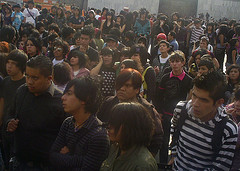UPDATE: In January 2012, we caught up with Jessie Daniels for her latest picks in the best of the best documentaries, and got replies from several other professors representing different courses. Please check out the new lists! https://thesocietypages.org/specials/documentaries/
Here are more items suggested by the commentors:
Josh Page, a professor of sociology (particularly law, crime, and deviance) at the University of Minnesota, sends in his Top Five list for teaching undergrad courses on the criminal justice system, noting “The ‘reality’ TV stuff about prison life is pretty much uniformly bad.”
Top Five Prison Documentaries for Crime and Punishment Courses
1. Sweethearts of the Prison Rodeo (2009) http://sweetheartsoftheprisonrodeo.com/
2. The Dhamma Brothers (2008) http://www.dhammabrothers.com/
3. The Farm (1998) http://www.imdb.com/title/tt0139193/
4. Writ Writer (2008) http://www.writwritermovie.com/
5. Ghosts of Attica (2001) http://icarusfilms.com/new2001/gho.htmlFavorite Re-entry Documentary
Omar and Pete (prison reentry) (2005) http://www.pbs.org/pov/omarandpete/
Another great friend of The Society Pages, Prof. Andrew Lindner of Concordia College, Moorhead, writes in with his own favorite documentaries with teaching. He said he’d have included “49 Up,” but since it had already been mentioned, these are his next Top Five, culled from the film series he puts on every semester at Concordia:
But I do a film series every semester on campus, so here are a few not mentioned:
1. “Manufactured Landscapes” (2006), based on the work of photographer Edward Burtynsky, it has some unbelievable footage from Chinese factories. Great for teaching about globalization and capitalism.
2. “Paradise Lost: The Child Murders at Robin Hood Hills” (1996) – a classic documentary on the (now recently freed) West Memphis Three. A powerful and disturbing illustration of stigma and social control.
3. “The War Room” (1993) – an insider’s look into Bill Clinton’s path to victory in the 1992 primaries. I use this in my “Political Sociology” course to talk about rhetoric, political strategy, and political professionals.
4. “Flow: For Love of Water” (2008) – a terrifying documentary on our dwindling water supply and how it is owned and managed by corporations for profit. Great for discussions of capitalism, privatization, or environmental sociology.
5. “Secret of the Wild Child” (1994) – an outstanding PBS/Nova documentary on feral children, particularly the famous Genie case mentioned in almost every sociology text. Challenges many students assumptions about socialization.
Nathan Palmer shares:
This is such a great idea and I’d like to thank TSP and Jessie Daniels for doing this. Resources like this and The Sociological Cinema make finding great videos for our classes so much easier. Thanks for taking the lead on this and for allowing the rest of us to share.
My Top Five Documentaries.
Race The Power of an Illusion Pvert 3: The House We Live In (2003)
My favorite film to show how historic and institutional racial discrimination is affecting us to this day. It does a great job connecting whiteness to citizenship and explaining red lining/block busting. I use it in my 101s and race & ethnicity classes.
The Color of Fear (1994)
An oldie, but a goodie. The film is a recording of 9 men of different racial ethnic backgrounds talking candidly about race. My only critique of the film is there are no women included and multiple racial groups are left out as well.Food Inc. (2008)
More than anything I want my students in my environmental sociology class to understand how social inequality and environmental degradation are connected. The portion of this film dedicated to the mistreatment of farmers, factory workers, and the animals/land they use is priceless.
The Battle for Whiteclay (2008)
This independent film documents how 4 liquor stores in Whiteclay, NE (a town of 14 people) sell 12,500 cans of beer a day. The off-sale liquor stores take advantage of their proximity to the Pine Ridge Reservation, who banned alcohol sales and possession on their lands. Despite there being no legal place for the 12,500 cans to be consumed (Whiteclay only has off-sale establishments) there have been nearly no arrests while the liquor dealers make millions of dollars annually. The video is an excellent example of government corruption, exploitation, and selective law enforcement.Inside Job (2010)
The 2008 credit crisis is a perfect example of how changes at the institutional level have a cascading affect all the way down to the individual. It also gets at how social problems are socially constructed. This film more than any other explains the complex crisis in a way that is approachable.
From Sarah Lageson:
One site I have relied on for seeking out sociologically relevant videos is Sociology at the Movies.
I also think a neat project for students in food or labor-related courses is to view Edward R. Murrow’s Harvest of Shame, then view a selection of contemporary documentaries that highlight how little has changed since 1961. Some really great documentaries include:
Carolyn Liebler says:
I often use movie clips in introduction to sociology when introducing a set of theories or concepts. Students use the movie clips to pull out examples of each theory/concept. They appreciate the chance to apply sociology to their regular lives.
For example, I show a short clip from:
1) Little Miss Sunshine – for students to pick out examples of material culture, non-material culture, subculture, counterculture, face and face work, front stage, and back stage behavior.
2) Wedding Crashers – as a way to apply the following theories of deviance: rational choice, labeling theory, differential association theory, and obligatory action.
3) The beginning of Ghostbusters – to apply the three major tenets of ethical research methods
4) Fiddler on the Roof – to play “spot that social institution!” and talk about how social institutions are interrelated.
Dedicated friend-to-TSP Joe Soss sends in this list of his Top 5:
1. At the River I Stand
2. Merchants of Cool
3. Occupation: Dreamland
4. Stonewall Uprising
5. Inside Job
And one from a student, Thom Friend:
College student here, taking courses on media & gender. Some of my favorite documentaries we have viewed in the classroom:
– Generation M: Misogyny in Media & Culture
– The Mickey Mouse Monopoly
– Iron Jawed Angels (Dramatization of the Women’s Suffrage Movement)
– Tough Guise: Men and Masculinity in Media
– Further Off the Straight & Narrow
– Makers (PBS)Then some of my personal recommendations:
– Zeitgeist: Moving Forward
– Power and Terror: Noam Chomsky
– Forks Over Knives
What makes students happier than watching movies during class time? — A new blog post provides some beneficial guidance in selecting films for specific sociological topics.
A recent update to the blog titled ‘Thinking at the Interface‘ provides a thorough and exemplary list of films to use in sociology classes. The list is organized around common themes of introductory sociology courses including the sociological imagination, research methods, race, ethnicity, and gender, just to name a few!

 Its not just a fantasy anymore, someone is actually teaching a ‘Sociology of the Simpsons’ course…Professor Darren Blakeborough of University College of the Fraser Valley as reported by
Its not just a fantasy anymore, someone is actually teaching a ‘Sociology of the Simpsons’ course…Professor Darren Blakeborough of University College of the Fraser Valley as reported by  The Houston Chronicle
The Houston Chronicle In a new editorial from the
In a new editorial from the  CBS news
CBS news